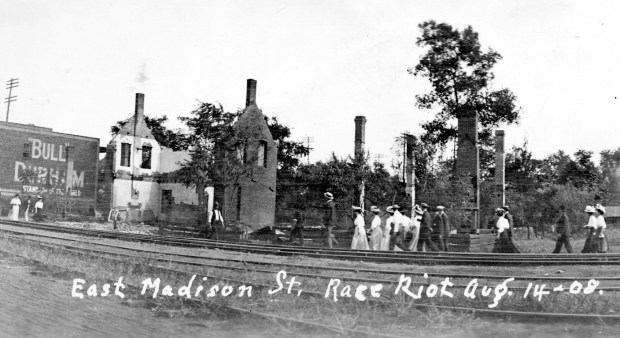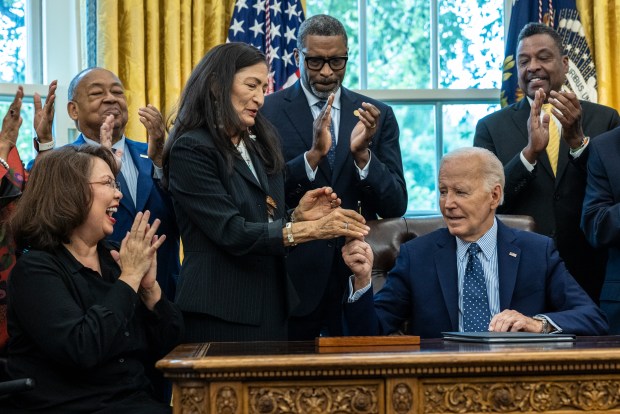SPRINGFIELD – President Joe Biden on Friday signed a proclamation designating the site of the 1908 Springfield Race Riot, one of the most egregious outbreaks of race-related violence in American history, as a national monument.
The riot has long been a calamitous symbol of the racism and intimidation that many Black Americans have endured in America. In recent years, both of Illinois’ Democratic U.S. senators, Dick Durbin and Tammy Duckworth, pushed for the legislation to prioritize the site of the riot as a national monument, and advocates have urged Biden to use his authority under the Antiquities Act of 1906, a federal law that protects cultural and natural resources of historic or scientific interest, to make that a reality.
That came to fruition on Friday, two days after the 116th anniversary of a riot that erupted just blocks from where President Abraham Lincoln once lived.
“It literally shocked the conscience of the nation,” Biden said at the Oval Office, flanked by Durbin, Duckworth, Democratic U.S. Rep. Nikki Budzinski of Springfield and others. “We have no safe harbor unless we continue reminding people of what happened.”
According to the White House, the monument will serve as a reminder of “the hateful violence targeted against Black Americans, and the power of dedicated individuals to come together across racial lines to transform shock and grief into good and action.”
The monument will protect 1.57 acres of federal land in Springfield and will be managed by the U.S. Department of the Interior’s National Park Service. In the coming years, the park service will work with community groups “to plan for interpretation, commemoration, and visitor experiences associated with the new park site,” the White House said, including the charred foundations of five homes that were never rebuilt.
Those homes were among dozens burned to the ground by an angry White crowd that ran amok after two Black men accused of rape and murder were spirited out of town by authorities.
The riot spurred the formation of the National Association for the Advancement of Colored People, which was founded on Feb 12, 1909, Lincoln’s 100th birthday, after Black leaders including Ida B. Wells-Barnett and W.E.B. DuBois called for the creation of a national organization to fight for equality and rail against racist policies.
Biden’s announcement comes as the Springfield-area has faced another reckoning in recent weeks with the police killing of 36-year-old Sonya Massey, whose death led to protests across the U.S. Massey’s family has said she was a descendent of William Donnegan, a shoemaker who was involved in the Underground Railroad and was lynched during the 1908 riot.
Walter Katz, the deputy chief of staff of public safety to Chicago Mayor Rahm Emanuel, specializing in police reform and accountability, also has a connection to Donnegan. Katz said in a Tribune op-ed last year that Donnegan was his great-great-great-granduncle, something he learned through an investigation of his ancestry and tied that to his chosen career path as a public defender and social justice advocate.
“So many Black Americans can point to someone in their family, in their extended family, who’d either been a victim of racial violence or a victim of police overreach of being an illegal stop or an illegal search or a use of force or a false arrest,” Katz said in an interview on Friday.
Teresa Haley, immediate past president for the Springfield branch of the NAACP, said the city remains racially segregated more than a century after the riot. Haley said she pushed for the national monument status for the riot site along with elected officials and that Biden’s announcement meant a lot to her because it’s important that people understand the adverse impact the riot had on Black residents.
“What we’re hoping now and what I want to see is when people come to Springfield and they come over where the memorial and the monument is being placed, that it’s an opportunity to reflect,” Haley said. “It’s an opportunity to think and put yourself, imagine yourself living during that era, experiencing that race riot. And Black people and white people lost their lives.”
The chain of events leading to the riot began on Aug. 14, 1908, when two Black men, Joe James and George Richardson, were held in jail. Richardson was accused of raping a white woman and James was accused of killing a white man.
A large mob of white people gathered outside the jail demanding the two men be released so the group could lynch them. To prevent that, the county sheriff and a white business owner secretly moved the two men out of the jail and put them on a train, which took them to another jail about 60 miles away in Bloomington.
When the mob learned of this, it grew violent, burning Black-owned homes and businesses in Springfield and attacking residents and business owners. Within a couple days, about three dozen businesses in one neighborhood — half of them Black-owned and many of the others Jewish-owned —- were looted and vandalized. Several dozen homes of Black residents in the city were also destroyed.

Illinois Gov. Charles Deneen called in the Illinois National Guard to bring the rioting under control.
Ultimately, James was convicted of murder and sentenced to death by an all-white jury. Richardson was freed after the woman who accused him of rape recanted her story.
In a statement issued earlier this week, Sen. Durbin, who has a home in Springfield, said the race riot was “a violent and hateful tragedy” that “we cannot turn a blind eye to.”
“Together, we can honor the lives lost during the deadly riot and reaffirm our commitment to fighting prejudice in Illinois and across the country,” he said.
During the Democrats’ annual political rally at the Illinois State Fair in Springfield on Wednesday, Budzinski stressed the importance of the monument’s creation to educate future generations of residents and visitors to the capital city about the riot and to ensure it’s not forgotten.
“We’re coming out of the murder of Sonya Massey, being able to recognize our history in Springfield and telling the honest truth and history of our city and our community, and how we can be looking forward, how much more progress we still have to make,” Budzinski said.
Katz called the proclamation “an important and overdue move,” calling the riot “an undertold story, which still has reverberations today.”
“We still have these vestiges, which we see in, for example, the vestiges of redlining, where people of color, Black people, were not allowed to live in a lot of places in northern cities,” he said. “So today, the commemoration is recognizing the importance of history and the importance of the Black experience within the American fabric and especially since we have seen such a push over the last couple of years, this backlash of the teaching of history.”




